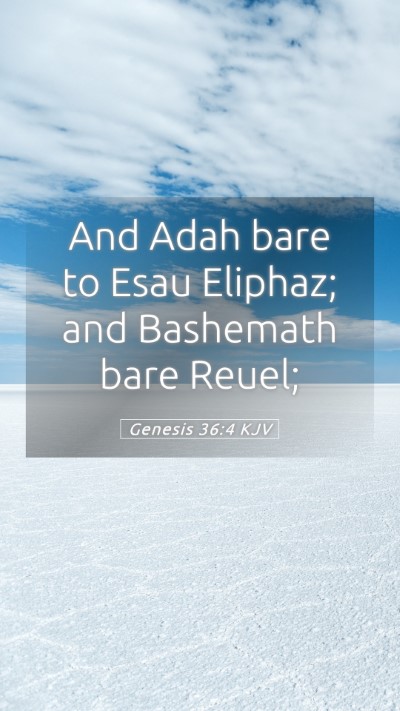Understanding Genesis 36:4
Genesis 36:4 states, "And Ada bore Eliphaz to Esau; and Ada was the daughter of Elon the Hittite, and the
sister of Aholibamah the daughter of Anah." This verse opens a rich tapestry of family relations and
outlines the genealogy of Esau, a significant figure in biblical history. In this summary, we will explore
the deeper meanings and interpretations drawn from various public domain commentaries, including insights
from Matthew Henry, Albert Barnes, and Adam Clarke. Our goal is to provide clarity and understanding for
those seeking explanations and interpretations of Scripture.
Genealogical Significance
The genealogies in the Bible are often seen as tedious by modern readers; however, they serve crucial
purposes. As highlighted in Matthew Henry's commentary, genealogies provide a historical record that
reinforces the legitimacy of the lineage of key biblical figures. In this case, Eliphaz, the son of Esau,
serves as a continuation of the narrative about the descendants of Jacob and Esau, two brothers whose
story is foundational to understanding the nation of Israel and its neighboring peoples.
The Role of Women in Genealogies
In this verse, we see Ada and Aholibamah being named, which emphasizes the important roles women play
within the biblical narrative, as pointed out by Adam Clarke. While genealogies typically focus on male
descendants, the inclusion of these women suggests recognition of their contributions to the family lineage.
This perspective offers a broader view of heritage that encompasses both maternal and paternal lines.
Relational Dynamics
The relationships presented in Genesis 36:4 illustrate the interconnectedness between tribes and families.
Albert Barnes notes that such connections are vital to understanding the geopolitical landscape of
the time. Esau's links to Hittites through marriage show how boundaries were both culturally and
relationally defined, signifying the essentiality of alliances through intermarriage.
Cultural Context
This verse must be interpreted within its cultural context. The Hittites were one of the prominent
civilizations during the time of Esau, noted for their influence and governance in Canaan. As per
Matthew Henry's commentary, Esau's marriage into Hittite families may also suggest ongoing struggles
for land and recognition, setting the stage for future conflicts between his descendants and those of Jacob.
Understanding this context enriches our reading of the text.
Modern Application
For contemporary readers, Genesis 36:4 offers insights into the importance of family heritage and
relationships. In a world that often emphasizes individualism, Scripture encourages us to recognize
our connections to previous generations, as highlighted in biblical exegesis. It reminds us that we are
a part of a larger narrative that spans generations, guiding our faith and identity today.
Key Themes and Cross References
The key themes that emerge from Genesis 36:4 include genealogy, relational dynamics, and cultural
significance. Additional biblical references that complement and provide a broader understanding of this
verse include:
- Genesis 25:30-34: The story of Esau selling his birthright.
- Genesis 27: Esau’s blessing by Isaac and its implications.
- Genesis 36:9: Further genealogy of Esau and its relevance.
Conclusion
In summary, Genesis 36:4 offers rich insights into the complexities of biblical narratives through its
genealogical recording. By considering the commentaries of Matthew Henry, Albert Barnes, and Adam Clarke,
readers can gain a deeper understanding of Scripture. Whether through Bible study groups or personal study,
engaging with passages like this one allows for deeper biblical exegesis and application to our lives today.
As believers, these interpretations enrich our Bible study insights, helping us to see the value of past
stories in shaping our faith journey. Such exploration will encourage readers to ask important questions
about their own spiritual heritage and life's significant relationships.


